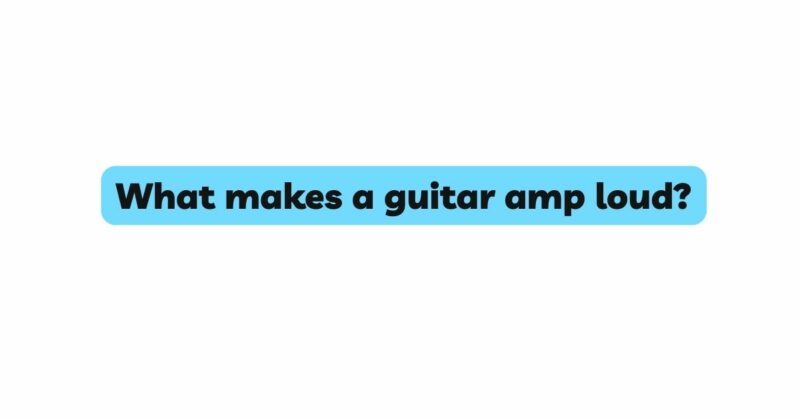The roar of a powerful guitar amp is a defining element of the rock ‘n’ roll soundscape. But have you ever wondered what precisely makes a guitar amp loud? The quest for volume goes beyond mere decibels, encompassing a symphony of components, technologies, and physics that shape the amplifier’s ability to project sound with authority and impact. This article delves into the intricate mechanics behind the loudness of a guitar amp, exploring the role of amplification, speaker efficiency, wattage, and the interactions that culminate in the sonic spectacle that is a loud guitar amplifier.
The Role of Amplification: At the heart of a guitar amplifier’s ability to produce volume is the process of amplification itself. Amplification involves taking the weak electrical signal generated by the guitar’s pickups and magnifying it to a level that can drive a speaker to produce audible sound. The amplifier’s preamp and power amp sections play a crucial role in this process.
Preamp Amplification: The preamp section of a guitar amplifier boosts the signal generated by the guitar pickups. It introduces gain, shaping the tonal characteristics and adding distortion or overdrive if desired. While the preamp is responsible for sculpting the tone, it doesn’t significantly contribute to the overall loudness of the amplifier.
Power Amp Amplification: The true loudness of a guitar amplifier is determined by the power amp section. This stage takes the signal from the preamp and magnifies it to drive the speakers. The higher the power amp’s amplification capability, the louder the amplifier can be pushed. Power amp distortion, known as power amp saturation, can also contribute to the perceived loudness by introducing harmonic content to the sound.
Speaker Efficiency and Sensitivity: The speaker is the conduit through which the amplified guitar signal is converted into audible sound. The efficiency and sensitivity of the speaker play a pivotal role in determining how loud the amplifier can be.
Efficiency and Conversion: Speaker efficiency refers to the speaker’s ability to convert electrical energy into sound energy. A more efficient speaker requires less power to produce the same level of volume compared to a less efficient one. High-efficiency speakers can significantly enhance the perceived loudness of a guitar amplifier while consuming less power.
Sensitivity Rating: The sensitivity rating of a speaker quantifies its efficiency. It’s expressed in decibels (dB) and indicates how loud the speaker will be at a specific distance with a specific input power. A higher sensitivity rating corresponds to a louder speaker. For example, a speaker with a sensitivity of 100 dB SPL (Sound Pressure Level) at 1 watt and 1 meter will produce 100 dB of sound with just 1 watt of input power.
Wattage: Wattage is often associated with the loudness of a guitar amp, but it’s a nuanced factor. The relationship between wattage and perceived loudness is not linear; doubling the wattage doesn’t double the perceived volume. Instead, it results in a 3 dB increase in sound pressure level, which is a noticeable but not dramatic change in loudness. In practical terms, a 100-watt amp is only marginally louder than a 50-watt amp.
Distortion and Perceived Loudness: While clean tones are essential, the presence of distortion or overdrive can influence how loud an amplifier seems to our ears. Distortion adds harmonics to the sound, creating a sense of fullness and density that can make an amp appear louder than it actually is. The brain perceives more harmonically rich sounds as being louder due to their increased perceived complexity.
Room Acoustics and Sound Perception: The acoustics of the room in which an amplifier is played also influence how loud it sounds. The reflective surfaces, room size, and layout can impact sound dispersion and reflections, affecting the listener’s perception of volume. In a reflective room, sound waves bounce around, increasing the perceived volume. Conversely, in a well-damped room, sound waves are absorbed, leading to a more controlled perception of volume.
Master Volume Control and Power Scaling: Modern guitar amplifiers often feature master volume controls that allow players to adjust the output level while still achieving power amp distortion. This feature can be beneficial for achieving high-gain tones at lower volumes. Some amplifiers also employ power-scaling technology, which reduces the amplifier’s wattage while maintaining tonal characteristics. This enables players to achieve power amp saturation and distortion without excessive volume.
Overdriving the Power Amp: Pushing the power amp into distortion can significantly impact the perceived loudness. Power amp distortion generates harmonic content that fills out the sound, creating a more intense sonic presence. This can make the amplifier seem louder even if the actual sound pressure level hasn’t increased significantly.
Conclusion: The loudness of a guitar amplifier is the result of a symphony of factors, each playing its unique role in shaping the sonic experience. Amplification, speaker efficiency, wattage, distortion, room acoustics, and even listener psychology intertwine to create the illusion of volume and power. While wattage and speaker sensitivity contribute to the objective measurements of loudness, it’s the harmonious interplay of these elements that truly defines the electrifying experience of cranking up a loud guitar amp and letting the music roar.


